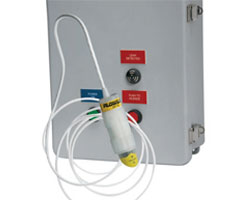Sensors from Chemical Injection: The Power of Leak Detection
Chemical leaks present major challenges on a multitude of levels. Not only do they indicate something has gone wrong, but they can cause damage to storage facilities, danger to employees, cost enormous amounts to fix and cleanup, and waste the chemical you’re storing.
 In extreme situations, the lack of a leak detection system can result in catastrophic events, like the chemical spill in the Elk River in West Virginia. In this post, we’ll take a look at the different causes of leaks, what leak detection does, and the types of leak detection available.
In extreme situations, the lack of a leak detection system can result in catastrophic events, like the chemical spill in the Elk River in West Virginia. In this post, we’ll take a look at the different causes of leaks, what leak detection does, and the types of leak detection available.
What Causes a Chemical Leak?
Leaks can occur for a number of different reasons. Beyond having a problem with the tank structure itself, there are three common causes:
- A loose or leaking fitting
- A broken pipe
- An overfilled tank caused by problems with the pump mechanism upon filling by the tanker truck
How Does Chemical Leak Detection Work?
Most chemical storage tanks have a secondary containment system – especially in the cases of municipal projects and situations where it is necessary to store a dangerous chemical.
Leak detection can be achieved through the placement of a device that sits at the bottom of a secondary containment area, or in between the inner or outer tank of a nested tank. This sensor will alert workers that fluid has escaped its primary containment.
The alarm that results from a leak detector sends a signal via relay that lets workers know that liquid is escaping from the primary tank into a containment area. Depending upon the preferences of the plant or facility, notification will occur through an audible alarm sound, a flashing light, or the signal is sent to a tracking system in a control room.
Benefits of Proper Leak Detection
There are, of course, several cost benefits to installing proper leak detection. Obviously, these systems will be crucial in the event of a major spill, but there are also some practical day-to-day benefits to including leak detectors in your chemical storage solutions.
First, leak detectors work with sensors that can be added through the entire storage system, including the initial chemical injection, to help alleviate risk of an overfilled tank. You can also add sensors along double-walled piping if you’re concerned about the journey of the chemical. In this way you can protect the integrity of the chemical and the storage system from beginning to end.
By using a Safe-Tank chemical storage tank, you’re ensuring that any chemical leak is detected by sensors, thus keeping containment in tact. This means that your employees, your facility, and the environment are all still safe from harm and if the leak is manageable, you can continue operations until a Field Service expert can address the issue. By not having to immediately shut down operations, you’re saving time and money for the plant and the employees.
With over 40 years of chemical storage expertise, we’ve learned that leaving open chemicals unnoticed in secondary containment basins for too long can be risky. In fact, the longer you leave chemicals in an open-top containment area, the higher the risk for contamination. This means the chemical is not usable and may have changed in chemical structure. Furthermore, it may need to be disposed of differently as its structure has become toxic. Leak detectors allow you to know right away that the leak has occurred, so that you can investigate the problem and contact the Field Service Department to have the problem assessed.
What Types of Leak Detection is Available?
The two most effective types of sensors are ultrasonic and optical leak detection devices. The optical option uses an infrared beam to detect liquid while an ultrasonic detector relies on sound. Ultrasonic leak detection uses a probe-like tuning fork that changes pitch when in contact with liquid. Both of the leak detectors are equally effective. Ultimately, the type of leak detector someone chooses is a matter of personal preference.
While not all municipalities and local codes require leak detection on chemical storage tanks, many customers choose to place these devices in their tanks for safety and productivity purposes. Of course, in cases where dangerous chemicals are stored, you may be required to have leak detection. If so, it’s smart to check to see whether or not leak detection is needed as well.
Learn more about incorporating proper leak detection for your chemical storage system by contacting a chemical storage expert today.
- March 18, 2015
- Topics: Fittings and Accessories
About Poly Processing
Posts By Topic
Tech Talk Podcast Episodes
Subscribe By Email
Recent Posts
- Installation Tips for Chemical Storage Tanks: Site Preparation and Offloading
- Understanding pH and Chemical Concentration When Choosing a Chemical Tank
- Maximizing Fill Efficiency: Selecting the Optimal Fill Line System
- Chemical Storage Tanks: A Quick Guide for End Users
- Popular Customization Options for Chemical Storage Tanks
Tank Configurator

Find the recommended tank and system components for your chemical storage challenge.
Configure a Tank Package


